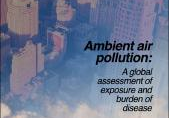Release of WHO data on air pollution exposure and its health impact by country

A new WHO air quality model confirms that in 2012, 479 000 Europeans died prematurely due to ambient air pollution.
The new global report, released today, presents the most detailed outdoor (ambient) air pollution and health impact data by country ever reported by WHO. The model, developed by WHO in collaboration with the University of Bath, United Kingdom, uses satellite-derived data combined with air transport models and ground station monitors from more than 3000 locations worldwide.
“The new WHO model provides countries with a baseline for monitoring progress in combatting air pollution and reducing its health impact, as well as showing where the data gaps are,” says Marie-Eve Héroux, Technical Officer Air Quality & Noise at the WHO Regional Office for Europe.
Impacts of air pollution on the health of European populations
From a global perspective, the WHO Western Pacific and South East Asian regions bear most of the burden, with 1.1 million and 799 000 deaths, respectively. Nevertheless, European populations have a higher life expectancy than in many other parts of the world, and older populations can be more vulnerable to the cumulative effects of air pollution on health, which is reflected in the crude burden of disease figures.
The report provides several indicators of the burden of disease from air pollution, with global estimates revealing that 94% of air pollution-related deaths are due to noncommunicable diseases (ischaemic heart diseases, stroke, chronic obstructive pulmonary disease and lung cancer). The report also includes age-standardized figures that take into account differences in life expectancy, and thus present a more realistic profile of the health impact of air pollution in the European Region. Country-level differences in underlying risk factors and baseline health status can be still significant, however.
Interactive map launch
Together with the launch of the report with the new data, an interactive map is also available to provide information on population-weighted exposure to small particulate matter (≤2.5 μm diameter; PM2.5) for all countries.
The map also indicates data on monitoring stations for PM10 (≤10 μm diameter) and PM2.5 for about 3000 cities and towns globally. It is particularly evident that monitoring capacity varies greatly throughout the WHO European Region: the map highlights where the data gaps are and raises the opportunity to improve air quality monitoring in the Region.
WHO/Europe work to improve air quality in the Region
WHO/Europe continues to work with its Member States and with other regional partners to revise policies and guidelines on air quality. In particular, the Regional Office is working with:
- the United Nations Economic Commission for Europe (UNECE) within the context of the Convention on Long-range Transboundary Air Pollution and the Transport Health and Environment Pan-European Programme (THE PEP); and
- the European Commission on providing advice for its policies on air quality.
Globally, WHO and the Climate and Clean Air Coalition have also rolled out BreatheLife, a communications campaign to increase public awareness of air pollution as a major health and climate risk. As part of the 2030 Sustainable Development Agenda, in 2015 governments around the world set the target: “by 2030 substantially reduce the number of deaths and illnesses from hazardous chemicals and air, water and soil pollution and contamination”.



